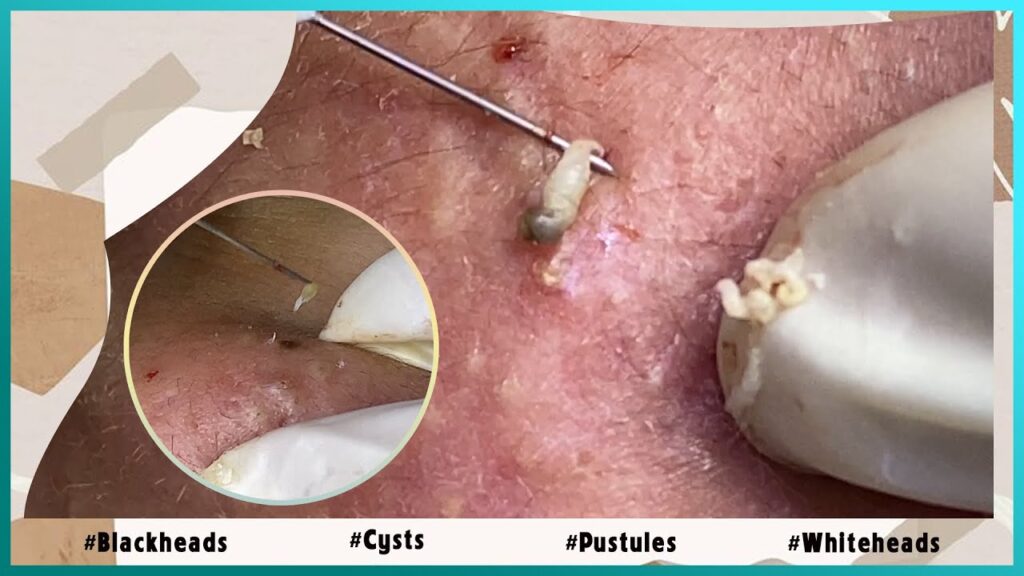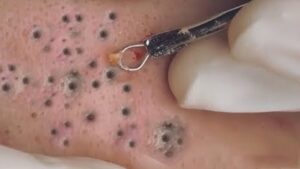Blackhead picking, though often stigmatized, is a widespread behavior that many individuals engage in.
What motivates someone to obsessively extract these small imperfections from their skin?
Delving into the psychology of a blackhead picker reveals a complex interplay of emotions, habits, and underlying psychological factors that drive this common yet often misunderstood behavior.
Here’s a sample video of someone doing this weirdly satisfying practice:
So what goes through the noggin of the typical blackhead picker out there roaming the streets right now? Let’s dive in!
Wait, What Is A Blackhead, Anyway?
A blackhead, also known as an open comedone, is a type of acne lesion that forms when a hair follicle or pore becomes clogged with a mixture of dead skin cells, oil (sebum), and sometimes bacteria.
Unlike whiteheads, which are closed comedones, blackheads remain open at the surface of the skin.
The characteristic dark appearance of blackheads is not caused by dirt but results from the oxidation of melanin, the pigment responsible for the color of our skin and hair.

When the contents of the clogged pore are exposed to air, they undergo a chemical reaction that darkens the material, giving the blackhead its distinct color.
Blackheads are a mild form of acne and can occur on various areas of the body, but they are most commonly found on the face, particularly on the nose, forehead, and chin.
Factors such as excess oil production, hormonal changes, and certain skincare or cosmetic products can contribute to the formation of blackheads.
While blackheads are generally harmless, picking or squeezing them can lead to inflammation, infection, and scarring.
It’s advisable to use gentle skincare practices, including regular cleansing and exfoliation, to help prevent their formation.
If blackheads persist or become a concern, consulting with a dermatologist can provide appropriate guidance and treatment options.
The Urge to Pick:
At the core of blackhead picking is a compulsive urge that some individuals find difficult to resist.
Whether driven by anxiety, stress, or a desire for perfection, the act of extracting blackheads can provide a temporary sense of relief and satisfaction.
Understanding the triggers behind this compulsion is key to unraveling the psychology of those who engage in such behavior.
Perfectionism and Control:
For some, the relentless pursuit of flawless skin fuels the compulsion to pick at blackheads.
Perfectionism, coupled with a desire for control, can lead individuals to engage in repetitive grooming rituals as a means of managing stress and maintaining a perceived ideal image.
The act of extracting blackheads becomes a tangible way to exert control over one’s appearance.
Stress and Anxiety Release:
Blackhead picking often serves as a stress-relief mechanism for individuals grappling with anxiety or heightened emotions.
The physical act of extraction can be a cathartic experience, offering a brief respite from the mental pressures that accompany daily life.
The satisfaction derived from “cleaning” the skin provides a momentary escape from emotional turbulence.
Sensory Gratification:
The tactile nature of blackhead picking contributes to its allure.
The sensation of squeezing and the immediate feedback from the skin create a sensory experience that can be oddly satisfying.
This tactile gratification may become a comforting ritual, offering a sense of control and order in the midst of life’s uncertainties.
The Cycle of Guilt and Compulsion:
Despite the momentary satisfaction, blackhead picking often leads to a cycle of guilt and compulsion.
Individuals may experience remorse for damaging their skin, only to succumb to the urge again when faced with triggers like stress or anxiety.
Understanding this cycle is crucial in addressing the underlying psychological factors driving the behavior.
Seeking Professional Help:
For those struggling with the compulsion to pick at blackheads, seeking professional help from dermatologists or mental health professionals can be beneficial.
Cognitive-behavioral therapy (CBT) and mindfulness techniques may assist individuals in addressing the root causes of their behavior and finding healthier coping mechanisms.
Conclusion:
The psychology of a blackhead picker is nuanced, involving a complex interplay of emotions, habits, and psychological factors.
Understanding the underlying motivations behind this common behavior is the first step toward developing effective strategies for managing the compulsion.
With empathy and awareness, individuals can navigate healthier paths to skincare and overall well-being
While it’s important to note that picking at blackheads can potentially damage the skin and exacerbate issues, here’s a lighthearted take on a “rogue’s gallery” of common blackheads that pickers might humorously refer to:

The Sneaky Squatter:
Nickname: Slippery Sammy
Description: Elusive blackheads that seem to hide beneath the surface, making pickers feel like they’re on a mission to uncover a hidden treasure.
The Stubborn Soldier:
Nickname: Rocky Remy
Description: Resilient blackheads that withstand multiple extraction attempts, leaving pickers feeling determined to conquer these persistent foes.
The Pore Invader:
Nickname: Invincible Ivan
Description: Blackheads that emerge seemingly overnight, invading pores and prompting pickers to wage a constant battle against these unwelcome visitors.
The Surprise Guest:
Nickname: Stealthy Steve
Description: Blackheads that appear unexpectedly in unusual places, surprising pickers with their sudden presence and triggering a swift removal mission.
The Illusionist:
Nickname: Tricky Terry
Description: Blackheads that mimic the appearance of larger issues, playing mind games with pickers and enticing them to engage in a strategic extraction process.
Remember, it’s crucial to approach skincare with care and consult professionals for advice on safe and effective methods.
Picking at blackheads can lead to skin damage, inflammation, and potential scarring. Always prioritize gentle skincare practices and seek guidance from dermatologists if needed.
